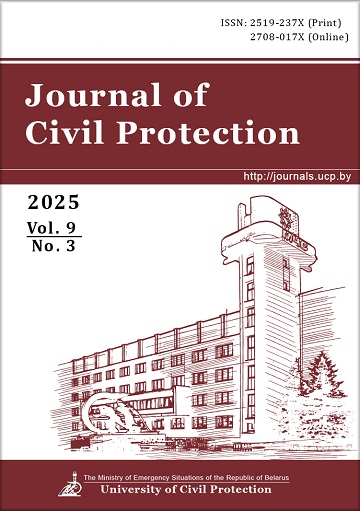Investigation of mechanical hysteresis under cyclic loading in bolted connection of crane slewing-bolt device
DOI:
https://doi.org/10.33408/2519-237X.2025.9-3.335Keywords:
hreaded joints, hysteresis loop area, finite element modeling, cyclic loading, bolted joint destruction, combined types of loadingAbstract
Purpose. Estimation of bearing capacity and areas of destruction of threads of bolt connection of the crane slewing support device.
Methods. The method of three-dimensional modeling in the Autodesk Inventor Professional environment, which allows to work with the assembly of solid bodies being in parametric dependencies between each other, was used to study the behavior of the bolt connection of the tower crane slewing device under cyclic loading.
Findings. The bolted connection of the tower crane slewing support device was investigated in ANSYS environment. The load acting on tested connection resulted in plastic deformations and then the tested connection was unloaded. The unloading occurred according to the elastic law, and the residual deformations were preserved. The most probable scenario of change in the plastic properties of the bolted connection was modeled, and the areas of critical stresses were determined. The developed finite element model allows describing the behavior of the bolted joint and determining the areas of thread destruction.
Application field of research. Prediction of strength loss in the most probable areas of overloading, and, as a consequence, displacement of bolted joint under small frequent loads.
References
Vol'mir A.S. Ustoychivost' deformiruemykh sistem [Stability of deformable systems]. Moscow: Nauka, 1967. 984 p. (rus)
Martynenko T.M., Smilovenko O.O., Martynenko I.M., Losik S.A. Komp'yuternoe modelirovanie razrusheniya boltovogo soedineniya oporno-povorotnogo ustroystva pod"emnogo krana [Computer modeling of the destruction of the bolt connection of the support-turning device of the crane]. Emergency Situations: Prevention and Elimination, 2023. No. 2 (54). Pp. 24–31. (rus). DOI: https://doi.org/10.54422/1994-439X.2023.2-54.24-31. EDN: https://elibrary.ru/LYBKPZ.
Dyakov I.F., Chernov S.A. K raschetu obolochki, ukreplennoy tonkostennymi sterzhnyami [Calculation of the shell reinforced by the thin-walled rods]. Automation and Modern Technologies, 2008. No. 1. Pp. 16–20. (rus)
Basov K.A. ANSYS v primerakh i zadachakh [ANSYS in examples and tasks]. Moscow: Komp'yuterPress, 2002. 223 p. (rus)
Klovanich S.F. Metod konechnykh elementov v nelineynykh zadachakh inzhenernoy mekhaniki [Method of finite elements in nonlinear problems of engineering mechanics]. Zaporozhye: Publishing and Printing Association «Zaporozhye», 2009. 400 p. (rus)
Ikrin V.A. Soprotivlenie materialov s elementami teorii uprugosti i plastichnosti [Resistance of materials with elements of the theory of elasticity and plasticity]: textbook for students studying in the direction 653500 «Construction». Moscow: ASV, 2004. 424 p. (rus)
Birger I.A., Iosilevich G.B. Rez'bovye i flantsevye soedineniya [Threaded and flange connections]. Moscow: Mashinostroenie, 1990. 388 p. (rus)
Nadai A. Plastichnost' i razrushenie tverdykh tel [Plasticity and fracture of solids]: in 2 vols; translation from English. Moscow: Mir, 1969. Vol. 2. 863 p. (rus)
Panovko Y.G. Vnutrennee trenie pri kolebaniyakh uprugikh sistem [Internal friction at oscillations of elastic systems]. Moscow: Fizmatgiz, 1960. 193 p. (rus)
Krasnoselskiy M.A., Pokrovskiy A.V. Sistemy s gisterezisom [Systems with hysteresis]. Moscow: Nauka, 1983. 271 p. (rus)
Published
How to Cite
License
Copyright (c) 2025 Martynenko T.M., Smillovenko O.O., Pronkevich S.A., Losik S.A., Martynenko I.M.

This work is licensed under a Creative Commons Attribution-NonCommercial 4.0 International License.




















